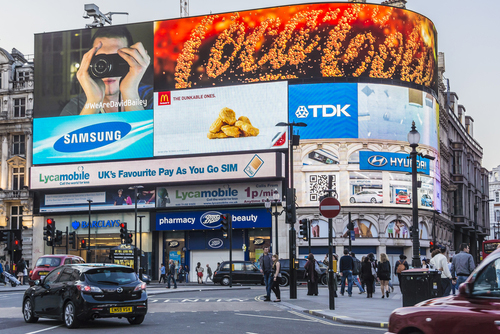It’s no surprise that traditional TV advertising no longer has the same influence when it comes to fighting for audience attention, with on-demand TV and second, or even third, screens now all contending.
To overcome this, retailers are realising that they need to switch their attention to digital out of home (DOOH) advertising, and look to digital solutions as a means of engaging today’s increasingly switched on audience.
Digital screens
Campaigns need to be innovative and original to grab the attention of an audience that is already swamped with information. Luxury online retailer Net-a-Porter recently launched its first ever DOOH campaign in Canary Wharf, using digital screens to show items being purchased from its site in real time, as well as where in the world the sale was taking place. This is a great example of how digital screens are being used to communicate information in a lively and eye catching manner, while simultaneously advertising Net-a-Porter’s global reach.
This kind of campaign is much more likely to engage and grab the attention of the on-the-go consumer than traditional billboards or posters.
Digital screens should be strategically placed in areas with high consumer traffic to engage a large audience and drive sales. As well as being used in the public space, digital screens can be used to good effect in store. With consumers more willing to undertake research in order to find the best price, retailers need to offer the best shopping experience to encourage customers to shop in their store rather than looking to a competitor or buying online. By giving potential customers a lasting and engaging shopping experience, digital displays can be used to convert casual browsers into brand ambassadors.
Pursue an integrated approach
Digital screens can be used in any number of ways but should always offer the consumer a chance to engage with the brand. Some of the world’s biggest household names, such as McDonalds and Google have already begun utilising screens that link with smart-phones. Passers-by are given displays that offer QR codes, for instance, which, once scanned, activate content on mobile devices.
Blippar is perhaps the best example of this – consumers hover their mobile devices over everyday objects in shops, or on adverts or posters which then triggers an animation on their mobile screen. This may be a short animation, more information about the product or a game that shoppers can take part in for example.
This kind of integrated approach, implemented across electronic billboards and on in-store screens, can give businesses a real edge over their competitors, especially when considering that the average person checks their phone an astonishing 110 times a day. Integrated, DOOH advertising is a great way for retailers to reach a busy, audience across a host of locations, whether out shopping, waiting for the bus or in town squares. Targeting consumers on their mobile devices enables the opportunity to engage, despite their busy and hectic lifestyles.
While QR codes have huge benefits in terms of their accessibility, visual recognition technology is now showing itself as an appealing option for digital integration. Not reliant on a fixed physical code, anything from a specific image or physical product can be used to prompt a link via a camera.
Other benefits lie with its ability to be easily managed by the brand or business deploying it. Unlike QR codes, visual recognition technology removes the need to reprint or redeploy when it comes to a change in campaign for example. Moreover, it’s also much more user-friendly for developers who don’t have to use enclosed platforms such as Blippar or Layar.
Personalisation
More and more, retailers are looking to gear content on digital screens to appeal to individual shoppers. This is largely achieved via none intrusive personalisation which uses technology, including iBeacons, to change content based on specific shopper information. This could be how close the shopper is to a digital screen; whether or not the majority of shoppers in the store are female or male, as well as external influences such as the weather. For instance, if there is a high number of traffic in the ladies wear department, digital screens will change to highlight ladies wear promotions.
Digital-first
DOOH advertising is on the rise, with revenues in the US increasing by 13%, from $840 million in 2012 to $950 million in 2013, according to Media Post. UK companies should also look to develop an integrated digital-first approach when it comes to out of home advertising if they are to stay ahead of their competition and reach an audience that has become more interactive.






